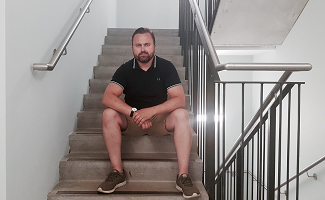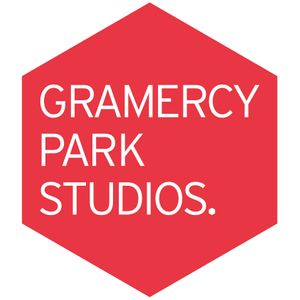
Model Making, Mean Streets and Motion Graphics

Billy Wright, Head of Motion Graphics at Gramercy Park Studios, takes LBB along his winding career path, explains his passion for knackered old clocks and Danish furniture, and what he’s planning for the future of his department…
LBB> Was your journey into motion graphics a simple one?
Billy> No, I’ve had quite a convoluted career path. I was always interested in art and design at school, so I went to art college when I was 16 and did a foundation course that covered pretty much everything: typography, oil painting, fine art – the usual stuff.
But, at that time, I didn’t have any friends or family around me who’d done anything in the creative field. So I was unsure about where to go next with my professional life and by the time art college had ended, I didn’t really have a plan.
After a year off doing some odd jobs and part time work, I realised I needed to get my act together. A few of my friends had gone off to the Kent Institute of Art & Design, which is now a huge behemoth that’s part of the arts facility at Canterbury, and I decided to follow them along and do a model making degree.
LBB> How do you feel the model making helped your career?
Billy> I really enjoyed the degree, but in reality it wasn’t the best course for my style. At art college, I enjoyed very tight graphic design and most of my drawings were dominated by line-work, so I should have perhaps pursued graphic design or illustration at university. However, model making certainly taught me a lot about patience, accuracy and discipline.
After graduating, I worked in product model making, creating precision scale models of things like audio equipment, bottles of beer or food for commercials. We’d create these beautiful models that could be five times the scale and would be used in commercials and magazine shoots, because if you used the actual products they would look pretty shit under the unforgiving scrutiny of a Hasselblad camera. It could take days or even weeks to build these perfect representations and one wrong move would destroy hours or even days of work. When you aren’t working on a computer and don’t have CTRL + Z at your disposal, being patient and disciplined is essential.
LBB> That sounds like a tremendous amount of pressure. Any horror stories?
Billy> Tons. The first job I went into, I was working on a Grolsch commercial and there were these three model bottles that some poor soul had spent days casting from resin, polishing and polishing, precisely recreating the logo on the glass, and getting the models in tip top shape ready for the shoot.
Someone said they needed 13mm shaved off the side of the bottles, but I misheard and shaved 30mm off all of them. I had to go upstairs to the bosses and admit that I’d just ruined three of these beautiful models – they must’ve cost something like £6000 a pop. You only make those mistakes a few times before they get tired of you. Luckily, that was my first day and for some reason I didn’t get fired!
LBB> So how long did you last in the model making profession?
Billy> I did it for a couple of years but I came to realise that I didn’t want to be creating other people’s visions; I wanted to start realising my own. I imagined that I would go back to university and study graphics and illustration, but then a runner position at Metro Broadcast, a post production house in Soho that has now fallen victim to the Crossrail wrecking ball, opened up and I thought I may as well give it a go until term started.
My step-father was a CAD operator so we always had high-spec computers around the house, and I had done a little bit of 3D and Photoshop art work before I joined Metro. Whilst I was running I became interested in the DVD department, not just because they were great guys, but because they gave me my first taste of motion graphics.
LBB> What did you learn during your time at Metro?
Billy> I learnt about After Effects, 3D Studio Max, and all of the necessary software, but more importantly was the fact that we were all, no matter how junior, client-facing which was invaluable. It was a bit of a baptism of fire really, and helped me develop in terms of taking ownership of projects, liaising with the client, going on shoots and seeing the entire process through from start to finish.
Eventually, I started pushing to get our department more of the title sequences, idents and lower thirds for some of the shows that were being worked on in other departments. Doing title sequences for TV shows was exciting, as rather than the stuff you’ve helped create going on a DVD that ends up in some bargain bin in Woolworths, you could see your titles come to life on the screen. We did some really cool in-programme graphics for a lot of now-defunct cable shows, worked with Bill Bailey on some very odd but funny ideas he had for graphics for his stage show, created typographic and animated sequences for Manic Street Preachers stadium gigs – a lot of odd, off-the-beaten-track type of stuff but often it was because we were trying to get recognised. We would say ‘yes’ to stuff that more established artists and post-houses might not, and as a result we often had more creative control on some cool projects.
LBB> What other projects stand out in your career?
Billy> Getting a hand-signed poster of Mean Streets from Martin Scorsese early on for a DVD menu I created was amazing as I’d only been working in the industry for a few years. A couple of years ago, I had a fantastic freelance project with Young’s that became a total labour of love. We were given nearly complete creative control from the CGI, the edit, the audio design, and shot the actual spot ourselves with live action on green screen. It was quite a long job, around five months from start to finish, but it stands out because it’s the only job where I’ve done absolutely everything. We were essentially our own creative directors, cameramen, editors.
It came together really nicely because when you have a holistic view of an entire job, you can preempt the graphics and any other issues you may have and shoot the spot with that in mind. The old adage, ‘sort it out in post’, can cause a lot of problems for motion graphics guys – as well as anyone else who works in post-production – so being able to have complete control was a Godsend.
LBB> Lots of clients wouldn’t be so trusting and brave to let go completely like that. Why do you think that Young’s allowed you quite so much creative control?
Billy> I think they wanted something fun and original. A lot of things they created would have their brand feel about them, their own kind of signature, I suppose, and might’ve felt like previous promo items. I think they wanted someone to almost take them by surprise. We were able to be as outlandish as we wanted to be and they were very accepting, which is really unusual especially for such a large job, but they’re very progressive like that. The fact that any idea was valid as long as it was relevant and didn’t degrade the quality of the brand in any way made it so much fun.
I have a passion for hand drawn illustration, so I made sure that I could hand-draw as much of the Young’s job as possible. The whole opening sequence was this kind of crazy Heath Robinson-esque brewery with kegs, barrels, stills and weird machines going off everywhere as the camera followed the beer flowing through all the criss-crossing pipes. It was such a great job.
LBB> Other than illustration, what other passions would you say you have?
Billy> I’ve always had an affinity for furniture, especially mid-century Danish furniture. I can’t tell you why really, but I guess it’s the whole Mad Men look and feel paired with the functionality of it all and my training taught me to appreciate architecture and furniture and product design.
Post-Bauhaus furniture where things are function-led and everything has a purpose is always something I look out for. Sometimes I find old bits of furniture from anywhere and everywhere – Gumtree, places online, vintage fairs – and I restore them. I’m just a bit of a sucker for old radios, cameras, or old clocks and sitting down and committing to getting them working again. It’s an extension of what I do in my career, but it’s also an appreciation of someone else’s work, which might be really different from what I usually design.
LBB> When did your career in motion graphics really take off?
Billy> After my time at Metro, I moved on to The Farm as their Head of Graphics. I enjoyed a good five-year period there but by 2012 I was pining for a new challenge that was closer to home. A small design agency in Reigate, where I was living at the time, created a role for me, and I was able to develop the motion graphics department alongside another colleague.
We did a lot of extremely technical work for big oil companies. I spent three years there and honed my skills and got used to handling big accounts, but three years later and I was ready to return to London.
LBB> You joined Gramercy Park Studios last year. What are your plans for the motion graphics department?
Billy> I’d like to see us really raise our head above the parapet and become known for outstanding work in our field. If a motion graphics team genuinely put passion and their own flair into the work it shows, and that’s what I want us to be known for. Ultimately I’d like our reputation for beautiful output to precede us and for word to spread to a multitude of new clients!













